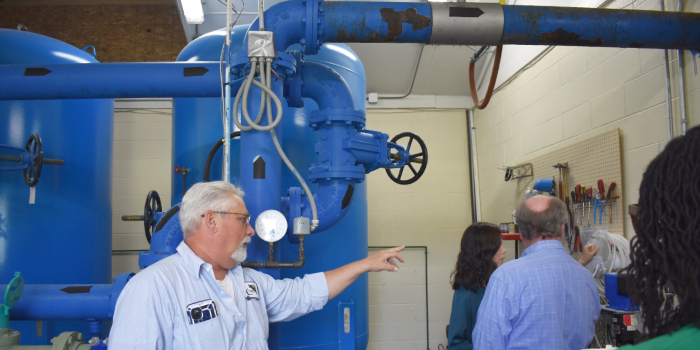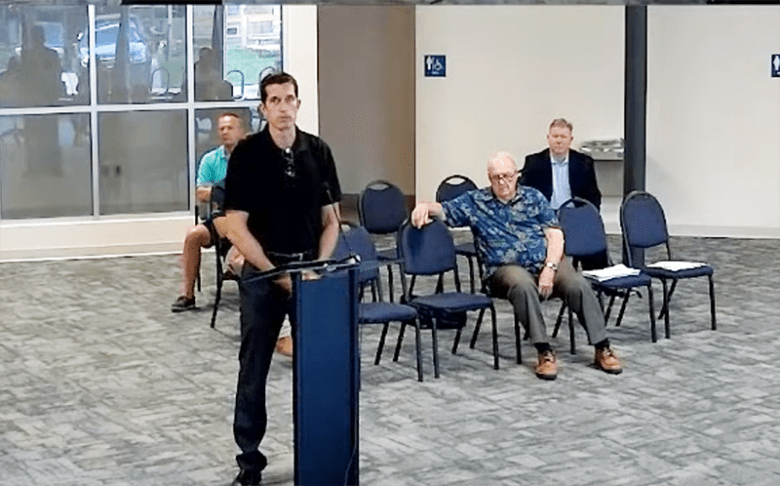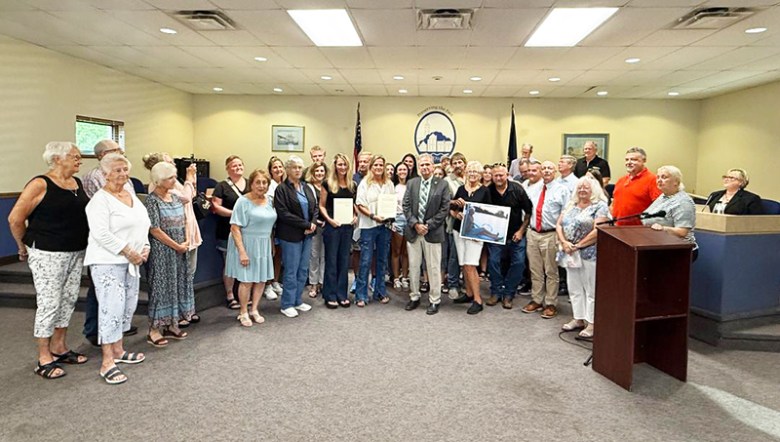Turkey Creek Sewer District Superintendent Tim Woodward leads a group through the Enchanted Hills water plant May 15. The small, aging utility has been difficult to find funding for, leaving applying to the State Revolving Fund as the best option. However, future funding for SRF may be cut under President’s Trump’s 2026 budget proposal. Photo by Lilli Dwyer.
KOSCIUSKO COUNTY — Improving the water quality in Milford has been a four-year endeavor involving utility studies, rate studies, asset management plans and grant applications. The effort has finally started to pay off, with the Indiana Clean Water and Drinking Water State Revolving Funds awarding Milford $6.9 million in low interests loans, with $4.7 million forgivable.
In Milford, the water is high in iron and contains the emerging contaminant manganese. A new filtration system, a mixer for the water tower and other improvements have been sorely needed.
Improving water systems conveys numerous benefits for users. Milford Clerk-Treasurer Tricia Gall said she will not miss drinking bottled water or the red stains on her appliances, and pointed out other residents will save money on water softeners and filters.
To complete the water improvement projects without any SRF funding “would have been next to impossible,” Gall said.
In 2024, more than 80 Indiana municipalities asked the SRF for a total of over $1 billion to improve drinking water systems, and it awarded money to 40. Over $168 million was awarded to what it considers disadvantaged communities, a category Milford and Syracuse qualify for.
In its 2024 report, the SRF states, “the DWSRF continued to experience high demand. … Because of the challenges of aging infrastructure and Lead Service Lines, the majority of funds were utilized for Transmission and Distribution projects again in SFY 2024 (66%).”
Meanwhile, in Washington, President Donald Trump’s budget proposal for 2026 would reduce federal spending for the Environmental Protection Agency’s distribution to state revolving funds by almost 90%, from $2.77 billion to $305 million.
In May, the Senate approved a continuing budget resolution that keeps revolving loan money for states, but eliminates $1.4 billion in earmarked loan funding for state water projects.
The SRF could be in danger of getting slashed while many small utilities are in a tight spot without it.
Across Lake Wawasee in Cromwell, residents of the Enchanted Hills trailer park are also experiencing iron in their water and low pressure problems.
Turkey Creek Regional Sewer District, which inherited the Enchanted Hills Water utility in 1989, applied to the SRF for water and wastewater utility improvements last year but wasn’t found grant fundable.
The aging water system was built in the early 1960s and serves 230 customers. Its small size and the scale of the improvements needed make it difficult to get funding. TCRSD has tried three times to fund improvements, so far without success. In the meantime, the district has pursued other means of gaining revenue.
In May, TCRSD approved a rate increase from $71.85 to $79.05. Board Attorney Andy Boxberger cited inflation as a main motivator behind the increase. According to the rate study TCRSD commissioned from Baker Tilly, the previous rates were not enough to keep up with the operations of the district.
And without SRF funding, Woodward explained, “there’s not going to be a water project. There’s no way we can do any really major things on the backs of 230 people at a flat rate … I don’t want to raise the water rates on those people unless I can give them a better quality of water and improve the infrastructure. They have a hard time paying what we charge them as it is.”
The idea of taking on new sewer customers to increase revenue has been raised at a previous board meeting, but TCRSD can’t do that without first expanding its plant.
The district has, in fact, been working on a sewer plant expansion for the past two years. The plant had been operating at the 90th percentile of its capacity. To take on new customers without an expansion would be to earn a sewer ban from the Indiana Department of Environmental Management.
This year, TCRSD will be paying about $1 million for new rotors out of its own pocket, expanding plant capacity by 62%. The other option was to add a new oxidation ditch, which would have cost $9 million.
The town of Syracuse is working on funding a $6.2 million project to replace parts of its 100-year-old water system. After applying for the maximum of $700,000 from the Office of Community and Rural Affairs, Syracuse will apply to SRF to help defray the remaining $4.4 million.
Rather than quality, Syracuse’s water problems mainly concern pressure. The system includes many undersized water mains, as well as lead gooseneck connectors.
To receive the SRF funding would not just help Syracuse meet the EPA’s lead removal mandate, but “we would provide much improved fire protection, the reliability of the system will increase tremendously, less main breaks and service line breaks. And a strong infrastructure draws business growth. We’d be prepared for the future with increased housing, increased industry,” said Aurich.
Currently, Syracuse Town Manager Dave Wilkinson isn’t worried about a potential loss of SRF funds.
“As far as we know, (SRF funds) appear to be safe. We’re moving ahead assuming they’re fine,” he said.
Syracuse’s last rate increase, effective January 2024, was instated with this project and other future improvements in mind.
Milford is still responsible for a remainder of $2.1 million, and water customers are seeing the effects of that in their monthly bills.
At its March 11 meeting, Milford Town Council approved raising water utility rates in response to the cost. The average water bill was $32.41 for 4,000 gallons per month. Under the new ordinance, the rate increased to $49.09 in phase one and will increase again to $53.19 in phase two, when construction is complete.
With a smaller town population of 1,556, there are fewer people to spread the extra cost among, leading to the increase.
Still, without SRF funding, the estimated post-project user rate would have been $96.09.
“We’re in a wait and see mode,” Jeff Hersha, Jones & Henry Engineers, said of SRF’s future. The firm works closely with TCRSD and has submitted its preliminary engineering reports and applications to the SRF.
“Whatever cuts were identified initially, at this point, haven’t necessarily been ratified by Congress. … There were supposedly a lot of quote unquote ‘environmental cuts,’ which is always a fear for SRF. Depending on how you view that funding, SRF is a clearly legitimate, cost effective benefit to the tax payers and municipalities. Other things may not be as important,” he went on. “None of us know yet whether the changes in Washington will affect the funding stream for the SRF.”
Hersha stressed the importance of clean water in daily life.
“We forget in the grand scheme of things that water and wastewater is the first order of differentiation between us, and second and third world countries,” he said.






